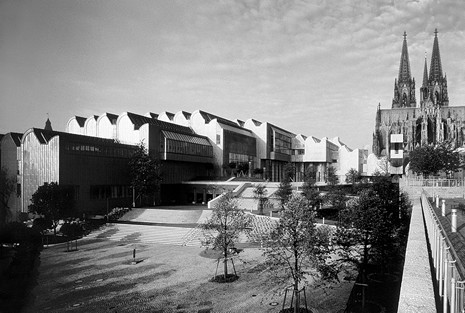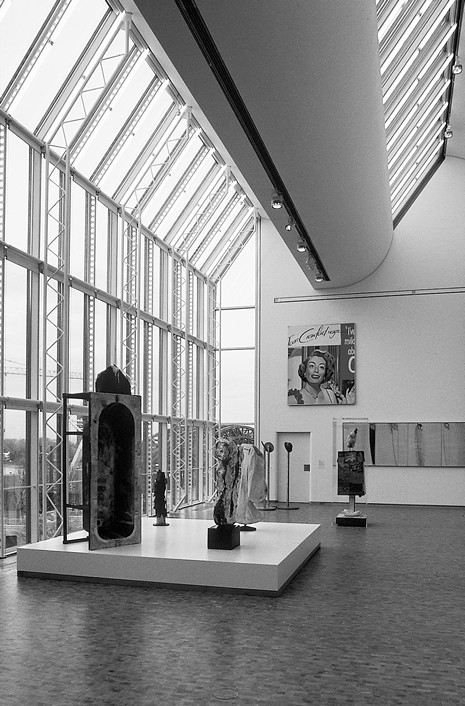Description
The real challenge for this project consisted in integrating a volume equal to that of Cologne Cathedral (and containing in addition to two museums, a concert hall as well) into the urban situation on the banks of the Rhine in Cologne – sadly neglected since the end of the war – at the foot of the Gothic cathedral. Chosen primarily for its virtues in relation to urban planning, the design recreates the old cathedral hill, sinking the concert hall into its interior (the technical difficulties that had to be overcome were enormous) and distributes the remaining spatial program over two volumes of different sizes which extend in an east-west direction, diminishing in height and breadth the closer they come to the Rhine, the larger of them containing the actual museum rooms. Between them there is a plaza that contracts toward the cathedral into a narrow passageway effectively staged as a view axis, while toward the Rhine, it broadens out into a wide stairway. The distinguishing characteristic of this architecture clad with red brick and titanium-zincked sheet metal is its sawtooth roof structure, consistent throughout, which on one hand organizes the building mass into small-scale units and probably also seeks to set it in relation to the filigree structure of the Gothic cathedral, while on the other hand resolving the problem so thorny for museums, the lighting, at the same time bringing it into view.
These sawteeth light the pictures and objects on the upper floor with a comfortable northern light, but their imposing form ‘overwhelms’ the exhibits, particularly in the smaller and lower-ceilinged exhibition rooms where the uniform dimensioning of the sawteeth appears to be quite out of proportion. On the two upper exhibition storeys, the ‘museum street’ runs along these sawteeth as a central access way from which the exhibition rooms, clearly organized and mostly axially interlinked, can be accessed. The access to this circulatory axis is via an enormous stairway leading right-angled to it, its almost baroque gesture in unexpected contrast to the discreet modesty of the entrance at the western end of the building facing toward the cathedral. It is true that the drama of this cascade of steps effectively opens perspectives, but in the final analysis, it leads to nothing because it ends in a room that feels far too low-ceilinged under the omnipresent sawtooth roof.
wettbewerbe aktuell 4/1976, pp. 235-254 • Bulletin der Museen der Stadt Köln, special issue 2/1986 • Hannelore Schubert, Moderner Museumsbau, Stuttgart, 1986, pp. 173-177 • Zwischen Dom und Strom. Neubau Wallraf-Richartz-Museum, Museum Ludwig und Kölner Philharmonie, ed. Hochbaudezernat der Stadt Köln, Cologne, 1986 • Bauwelt 37/1986, pp. 1408-1419 (Peter Rumpf) • Techniques et Architecture 368/1986, pp. 84-89 • The Architectural Review 1088/1987, pp. 38-45 (Colin Davies) • Architecture and Urbanism 199/1987, pp. 21-84 • Deutsches Architektenblatt 19/1987, pp. 267-272 (Christian Marquart, Replique der Architekten; Hugo Borger) • “Stimmen zum Kölner Museumsbau,” in: Kunstchronik 40/1987, pp. 293-329 (Judith Breuer, Christoph Bellot, Wolfgang Augustyn) and pp. 497-503 (Hugo Borger) • Werk, Bauen und Wohnen 4/1988, pp. 11-13 (Klaus-Dieter Weiss) • Jost Schilgen, Neue Häuser für die Kunst, Dortmund, 1990, pp. 136-157 • Josep Maria Montaner, New Museums, New York, 1990, pp. 50-57 • Laurence Allégret, Musées, vol. 2, Paris, 1992, pp. 82-89
Drawings
Site plan
Ground floor
Cross section through the Philharmonie
Photos

View of the museum exterior articulated by shed roofs and descending to the Rhine

View of an exhibition room opening toward the hill on which the cathedral was erected
Originally published in: Paul von Naredi-Rainer, Museum Buildings: A Design Manual, Birkhäuser, 2004.